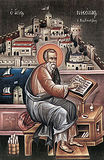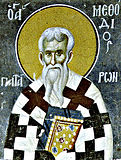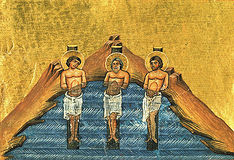

| Previous day | Next day |
| Old Style
June 20
|
Sunday |
New Style
July 3
|
|
3rd Sunday after Pentecost.
Tone 2.
Fast of the Holy Apostles. |
Fish, wine and oil allowed.
|
![]() Hieromartyr Methodius, bishop of Patara (or Olympus) in Lycia (312). Right-believing Prince Gleb Andreyevich of Vladimir (1175).
Hieromartyr Methodius, bishop of Patara (or Olympus) in Lycia (312). Right-believing Prince Gleb Andreyevich of Vladimir (1175).
Translation of the relics of Martyrs Inna, Pinna, and Rimma (1st-2nd c.), Scythian disciples of Apostle Andrew, to Alushta (Crimea) (1st c.-2nd c.). Hieromartyrs Aristocleus, priest, the deacon Demetrian, and the reader Athanasius, at Salamis on Cyprus (ca. 306). St. Leucius the Confessor, bishop of Brindisi (5th c.). St. Minas, bishop of Polotsk (1116). St. Nicholas (Cabasilas) (ca. 1397). Translation of the relics of St. Gurias, archbishop of Kazan (1630). St. Onuphrius, founder of Katrom Monastery (Vologda) (16th c.). Sunday of All Saints of Vologda. Sunday of All Saints of Novgorod. Sunday of All Saints of Belorussia. Sunday of All Saints of Pskov. Sunday of All Saints of St. Petersburg and Ladoga. Sunday of All Saints of Galicia. Sunday of All Saints of Poland. Sunday of All Saints of Odessa. Sunday of All Saints of Britain and Ireland. Sunday of All New Martyrs of the Turkish Yoke.
New Hieromartyr Nicholas Florov, archpriest, of Kobra (Vyatka) (1933).
“Korobeinikov” (Kazan) Icon of the Most Holy Theotokos (1938). Valaam Icon of the Most Holy Theotokos.
Martyrs Paul, Cyriacus, Paula, Felicilana, Thomas, Felix, Martyrius, Vitaly, Crispinus, and Emilius, in Tomis, Moesia (290). Blessed Studius, founder of the Studion Monastery (5th c.). St. Florentina, abbess, of Spain (ca. 636). St. Nahum of Ochrid, enlightener of the Bulgarians (910). Translation of the relics and garments of Apostles Luke, Andrew, and Thomas, Prophet Elisha, and Martyr Lazarus to the Church of the Holy Apostles in Constantinople (960). St. Callistus I, patriarch of Constantinople (1363). St. Nicephorus (Cantacuzene), archdeacon, of Constantinople, who suffered under the Uniates in Marienburg, Galicia (1599). Finding of the relics of New Hieromartyr Raphael, hieromonk, of Mytilene (1959).
Thoughts for Each Day of the Year
According to the Daily Church Readings from the Word of God
By St. Theophan the Recluse

Third Sunday After Pentacost. [Rom. 5:1-10; Matt. 6:22-33]
If therefore thine eye be single[1] thy whole body shall be full of light. But if thine eye be evil, thy whole body shall be full of darkness. Here the mind is called the eye, and the entire composition of the soul is called the body. Thus, when the mind is simple then it is light in the soul; when the mind is evil, then it is dark in the soul. What are a simple mind and an evil mind? A simple mind is one which accepts the word of God as is written, and is convinced beyond a doubt that all is indeed as is written. It has no deceit, no wavering, or hesitation. An evil mind is one which approaches the word of God with slyness, artful disputing, and questioning. It cannot directly believe, but subjects the word of God to its sophistry. It approaches the word not as a disciple, but as a judge and critic, to test something stated there, and then either scoffs at it, or says in a haughty manner, “Yes, not bad.” Such a mind has no firm tenets, because it clearly does not believe the word of God, and its own rationale is always unstable—today one way, tomorrow another. It has only wavering, confusion, questions without answers; everything is out of place with it, and it walks in the dark, fumbling its way. A simple mind sees everything clearly: every thing in it has a definite character, determined by the word of God. That is why every thing in it has its place, and it knows exactly how to behave with relation to things—it walks along open, visible roads, with complete assurance that they lead to the true goal.
[1] In Church Slavonic, the text translates as, If thine eye be pure.
Articles
 Hieromartyr Methodius the Bishop of PataraThe Hieromartyr Methodius, Bishop of Patara (Lycia in Asia Minor), was distinguished for his genuine monastic humility. |
 Blessed Prince Gleb Andreevich the Son of St Andrew BogoliubskyHoly Prince Gleb of Vladimir, named George in holy Baptism, was a younger son of the holy Prince Andrew Bogoliubsky (July 4). |
 The Holy Martyrs Inna, Pinna and RimmaThe Holy Martyrs Inna, Pinna and Rimma were Slavs from northern Scythia (modern Bulgaria), and they were disciples of the holy Apostle Andrew the First-Called. |
 The First Russian Saints: Inna, Pinna and RimmaNikolai SolntsevTo glorify the first national saints and pray to them is our duty and honor. |
 St Leucius the Bishop of BrindisiSaint Leucius the Confessor was born in the city of Alexandria of pious parents named Eudykius and Euphrosyne. They gave their son the name Eutropius. |
 St Menas, Bishop of PolotskSaint Menas, Bishop of Polotsk led an ascetical life at the Kiev Caves monastery. On December 13, 1105 he was consecrated Bishop of Polotsk. |






